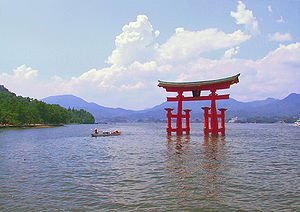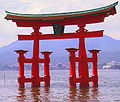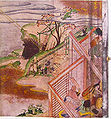- Itsukushima Shrine
-
Itsukushima Shinto Shrine * UNESCO World Heritage Site
Country Japan Type Cultural Criteria i, ii, iv, vi Reference 776 Region ** Asia-Pacific Inscription history Inscription 1996 (20th Session) * Name as inscribed on World Heritage List
** Region as classified by UNESCOItsukushima Shrine (Japanese: 厳島神社 Itsukushima-jinja) is a Shinto shrine on the island of Itsukushima (popularly known as Miyajima) in the city of Hatsukaichi in Hiroshima Prefecture in Japan. The shrine complex is listed as a UNESCO World Heritage Site and the Japanese government has designated several buildings and possessions as National Treasures.
Contents
Religious significance
The shrine is dedicated to the three daughters of Susano-o no Mikoto, Shinto deity of seas and storms and brother of the great sun deity, Amaterasu (tutelary deity of the Imperial Household). Because the island itself has been considered sacred, in order to maintain its purity commoners were not allowed to set foot on Miyajima through much of its history. In order to allow pilgrims to approach, the shrine was built like a pier over the water, so that it appeared to float, separate from the land, and therefore existed in a liminal state between the sacred and the profane.[1] The shrine's signature red entrance gate, or torii, was built over the water for much the same reason. Commoners had to steer their boats through the torii before approaching the shrine.
Retaining the purity of the shrine is so important that since 1878, no deaths or births have been permitted near the shrine.[2] To this day, pregnant women are supposed to retreat to the mainland as the day of delivery approaches, as are terminally ill or the very elderly whose passing has become imminent. Burials on the island are still forbidden.
Design history
The first shrine buildings were probably erected in the 6th century, and the shrine has been destroyed many times. The present shrine dates from the mid-16th century, and follows the earlier 12th century design.[3] That design was established in 1168, when funds were provided by the warlord Taira no Kiyomori. The shrine was designed and built on pier-like structures over the bay so that it would appear to be floating on the water, separate from the sacred island, which could be approached by the devout. Near the main shrine is a noh stage, funded by Toyotomi Hideyoshi in the late 16th century. Noh theater performances have long been used to pay honor to the gods, and ritually act out key events in the mythic history of Shinto belief.
The dramatic gate, or torii, of Itsukushima Shrine is one of Japan's most popular tourist attractions, and the most recognizable and celebrated feature of the Itsukushima shrine,[4] and the view of the gate in front of the island's Mount Misen is classified as one of the Three Views of Japan (along with the sand bar Amanohashidate, and Matsushima Bay). Although a gate has been in place since 1168, the current gate dates back to 1875. The gate, built of decay-resistant camphor wood, is about 16 metres high and was built in a four-legged style to provide additional stability.
The torii only appears to be floating at high tide; when the tide is low, it is approachable by foot from the island. It is common practice for visitors to place coins in the cracks of the legs of the gate and make a wish. Gathering shellfish near the gate is also popular at low tide. Many locals add the shellfish they gather to their miso soup. At night, powerful lights on the shore illuminate the torii.
On September 5, 2004, the shrine was severely damaged by Typhoon Songda. The boardwalks and roof were partially destroyed, and the shrine was temporarily closed for repairs.
 View from the torii
View from the torii
See also
- List of National Treasures of Japan (crafts-others)
- List of National Treasures of Japan (crafts-swords)
- List of National Treasures of Japan (paintings)
- List of National Treasures of Japan (shrines)
- List of National Treasures of Japan (writings)
- List of Shinto shrines
- List of World Heritage Sites in Japan
- Modern system of ranked Shinto Shrines
- Tourism in Japan
- Twenty-Two Shrines
Gallery
-
The torii at low tide
-
The torii at sunrise
-
The torii at sunset
-
The torii at night
-
Barrels of sake in one of the shrine's "floating" buildings
-
Itsukushima Shrine Family Crest
References
- ^ Turner, Victor W. (1969). The Ritual Process: Structure and Anti-structure. Chicago: Aldine Pub..
- ^ "Itsukushima". Japanese Lifestyle. 2010. http://www.japaneselifestyle.com.au/travel/miyajima_itsukushima.htm. Retrieved 17 March 2011.
- ^ Mason, Penelope (2004), Itsukushima Shinto Shrine "UNESCO's World Heritage Site", in Dimwiddle, Donald, History of Japanese Art (2nd ed.), http://whc.unesco.org/en/list/776 Itsukushima Shinto Shrine
- ^ "Japan Sightseeing Guide". japan-guide.com - Japan Travel and Living Guide. japan-guide.com. http://www.japan-guide.com/e/e623a.html. Retrieved 2009-01-17.
External links
- UNESCO World Heritage description
- Official Website of Miyajima Tourism
- Miyajima Guide including Itsukushima Shrine
- National Archives of Japan: Itsukushima kakei
World Heritage Sites in Japan Hokkaidō Tōhoku Shirakami-Sanchi · Historic Monuments and Sites of Hiraizumi
Kantō Shrines and Temples of Nikkō · Ogasawara Islands
Chūbu Historic Villages of Shirakawa-gō and Gokayama · Sacred Sites and Pilgrimage Routes in the Kii Mountain Range1
Kansai Buddhist Monuments in the Hōryū-ji Area · Himeji Castle · Historic Monuments of Ancient Kyoto (Kyoto, Uji and Otsu Cities) · Historic Monuments of Ancient Nara · Sacred Sites and Pilgrimage Routes in the Kii Mountain Range1
Chūgoku Hiroshima Peace Memorial (Genbaku Dome) · Itsukushima Shinto Shrine · Iwami Ginzan Silver Mine and its Cultural Landscape
Kyūshū Gusuku Sites and Related Properties of the Kingdom of Ryukyu · Yakushima
1 Shared with other region/sShinto shrine Shinto architecture Buildings - chōzuya or temizuya
- haiden
- heiden
- hokora
- honden / shinden / shōden
- kagura-den
- massha
- sessha
Architectonic elements Styles - hirairi-zukuri
- tsumairi-zukuri
- gongen-zukuri
- hachiman-zukuri
- hiyoshi-zukuri
- irimoya-zukuri
- ishi-no-ma-zukuri
- kasuga-zukuri
- kibitsu-zukuri
- misedana-zukuri
- nagare-zukuri
- ōtori-zukuri
- owari-zukuri
- ryōnagare-zukuri
- shinmei-zukuri
- sumiyoshi-zukuri
- taisha-zukuri
Others Implements Main kami Staff Head shrines1 - Fushimi Inari Taisha
- Usa Hachiman-gū
- Ise Grand Shrine
- Dazaifu Tenman-gū
- Munakata Taisha
- Suwa Taisha
- Hiyoshi Taisha
- Kumano Nachi Taisha
- Tsushima Shrine
- Yasaka Shrine
Miscellaneous 1 (in order of the size of the shrine network they head)
Coordinates: 34°17′45″N 132°19′11″E / 34.29583°N 132.31972°E
Categories:- 1160s architecture
- 16th-century architecture
- World Heritage Sites in Japan
- Shinto shrines in Hiroshima Prefecture
- Gates
- Visitor attractions in Hiroshima Prefecture
- Visitor attractions in Hatsukaichi
- National Treasures of Japan
Wikimedia Foundation. 2010.











